

 The South African
The South African
And yet the Transvaal Scottish Regiment - as a unit - was not present at Longueval and Delville Wood. Here's why. The two Active Citizen Force battalions of the 8th Infantry (Transvaal Scottish), as the regiment was then named, provided the core of a totally new unit formed for service overseas: the 4th South African Infantry Regiment (South African Scottish Regiment).
The reasons for this were complicated. When the Union of South Africa was formed in 1910, wounds were still raw from the Second Anglo-Boer War (1899-1902). Peace and unity were, understandably, only grudgingly accepted by many. They might fight in defence of this new country, but there would be active opposition to involvement outside the Union's borders, especially when that involvement would necessarily be aligned with the still-feared and distrusted British Empire. The Union Defence Act of 1912 recognised this by restricting operations of the Active Citizen Force (ACF) to 'defence of the Union ... whether inside or outside of the Union'. German South West Africa (Namibia today) was a clear threat to the Union, and so ACF units could fight there, as indeed the 1st, and 2nd, battalions of the Transvaal Scottish did. But to see German East Africa (today's Tanzania) as such a threat was a step too far. The same applied to the war against the Turkish Empire in North Africa, and even more so, to war in mainland Europe.
The solution was to raise completely new units, unrestricted in terms of their service. So were born, in late 1915, the 1st, 2nd, 3rd and 4th South African Infantry regiments that together formed the 1st South African Infantry Brigade. In the case of the 4th South African Infantry (SA Scottish), two of the four companies in this 1 400-strong battalion came from members of the Transvaal Scottish: 'B' Company from the 1st Battalion and 'C' Company from the 2nd Battalion.
Others have told the story of Delville Wood far better than I can hope to do here. So rather than attempt to reprise their work, I should concentrate on some of the strong associations between Transvaal Scottish and the 4th SA Infantry. Take the uniform, for instance. This new, but kilted, regiment sported the Murray of Atholl tartan, the same as that worn by the Transvaal Scottish, which had been founded by the eldest son of the seventh Duke of Atholl, then Lieutenant Colonel the Marquis of Tullibardine. When the 4th SA Infantry was in camp at Bordon, in Hampshire, for familiarisation training before heading to France, further kilts in the appropriate tartan were made available by the Duke of Atholl. The kilts came from his 'private' regiment, the Atholl Highlanders, the only such regiment permitted to this day in Britain. The duke also signified his willingness to accept the post of colonel-in-chief of the 4th SA Infantry, often seen as a purely honorary title, but in his case, leading to genuine involvement, as had also been the case when he became colonel-in-chief of the Transvaal Scottish back in 1910. It was hardly surprising then, that both Transvaal Scottish and the 4th SA Infantry marched to the tune of Atholl Highlanders. (The Duke of Atholl was never actually colonel-in-chief of the 4th SA Infantry, although the regiment sought permission for his appointment.)
Unit badges were an issue of contention. According to Major Donald Rolfe Hunt, formerly of 2nd Battalion Transvaal Scottish and who at one stage was in temporary command of the 4th SA Infantry, many members of the new unit saw it 'as an extension of 1st and 2nd TS'. Hunt wrote that many members 'continued to wear TS badges until a unit order prohibited this. The practice of wearing TS insignia continued surreptitiously, however, particularly among the officers!'
While the Transvaal Scottish strongly influenced the ethos of the 4th SA Infantry during the First World War, much the same thing happened in reverse, when the Transvaal Scottish was reactivated in 1920. Regarding this, Major Hunt was able to write that 'the TS was 80% controlled by former SA Scottish men - the OC, 3 Coy Cdrs, many officers, RSM and most of the CSMs and senior NCOs. As from 1920 the TS adopted the SA Scottish blue Atholl bonnet.'
The Transvaal Scottish Museum housed at 'The View' includes many exhibits directly or indirectly related to Delville Wood. The museum was effectively founded in 1964 by Peter Digby as a part of the King Edward VII School in Johannesburg. Digby had a family association with the regiment, while the school had equally strong connections. In 1978 the collection, as it then stood, was moved to 'The View'. It now covers everything from the founding of the regiment as the Transvaal Scottish Volunteers through two world wars and border operations.
The Transvaal Scottish Regiment has continued to value its association with the SA Scottish. In May 1995, for instance, a strong party from the regiment visited the Somme battlefields and, in particular, Delville Wood, as guests of the French Army. A service of commemoration was led by the Regimental padre, the Rev. Bill Marshall (ex-Argyll and Sutherland Highlanders, Parachute Regiment), who invoked the chill of the battlefield as the sun rose over it in a way that inspired those present. This year, in Johannesburg, the main Delville Wood commemoration is being hosted by the Transvaal Scottish Regiment on Sunday, 17 July, at 'The View' in Parktown. Three former commanding officers of the Transvaal Scottish will represent the regiment at this year's centenary ceremonies at Longueval, in France.
Yet, even as we remember, it is necessary to bear in mind that Delville Wood - with its horrifying 74 percent casualties during the days and nights from 14 to 20 July 1916 - was only one of many such savage encounters. In no way does it detract from the significance of the battle to consider this:
In the most current history of the First World War, written by Liddell Hart and published in 1992, Delville Wood is allocated a mere seven lines of text. If anything, this helps us to understand the sheer immensity of that conflict just a hundred years ago.
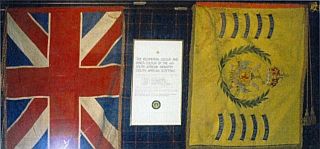
The 4th SA Infantry Regiment (SA Scottish) carried no Colours during its embodiment from 1915 to 1919, although an unofficial Colour was presented in 1915 by the then Duke of Atholl during training at Bordon Camp in Hampshire. Only in 1915 were official Colours handed over to the units that had provided men for the 1st SA Infantry Brigade, with a King's Colour and a Regimental Colour for 4th SAI being presented to the erstwhile honorary colonel, Colonel Sir William Dalrymple KBE, VD (Sir William was also honorary colonel of the Transvaal Scottish), to be kept at his Westcliff, Johannesburg, home 'Glenshiel'. The Colours were later laid up in Pretoria, at St Andrew's Church, where they deteriorated over the decades. Following long negotiations they were placed in the safekeeping of the Transvaal Scottish for restoration and preservation. The Regimental Colour displays Battle Honours earned by 4th SA Infantry. Despite strong urgings over many years - and unlike the situation as it applies in numerous Commonwealth units - the surviving South African units that had provided the troops who actually fought and earned them do not carry these Battle Honours. So it is that, sadly, this country's most distinctive Battle Honour from the First World War cannot be found on the Colours of today's SANDF units.
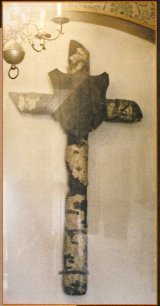
The original Delville Wood Cross hangs above the main stairs at 'The View'. Pioneers of the SA Scottish erected it after fighting died down, and the cross and shield show damage sustained from shell and rifle fire during the retreat of 1918. It was installed in St George's Presbyterian Church, Johannesburg, in 1924, at which time it was recorded: 'We are gathered today around a weathered and wounded Cross of wood, removed from a far famed battlefield ... the silver birch of which the cross is made, was cut within a few miles of the awful conflict. It was made by the men themselves and was set up by them on the battlefield. It has been sent to us across the seas that we in South Africa may preserve and treasure it, as a touching monument of the sacrifice of those that we have loved, and lost awhile.' In the 1990s the cross, together with the old Colours, was removed and taken to its present home at 'The View'. Another cross stands in the chapel of St John's College in Houghton, while two more such crosses found homes in Durban and Pietermaritzburg.
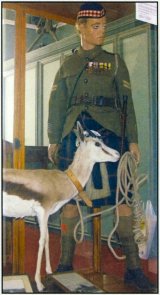
You can find several representations of the Springbok mascot who journeyed with the SA Scottish to the battlefields of France and Flanders. There's one at Ditsong National Museum of Military History, and here's another-skew-wise horn and all-at 'The View'. But if you want 'real', check out Nancy's handler in this display. Corporal John Quayle Greggor served with 1st Battalion Transvaal Scottish in the German South West Africa campaign and then with 4th SA Infantry (SA Scottish) in Europe. The tunic is the one he wore over there. Also original are his lanyard, collar dogs, wound stripe, shoulder titles and the bandsman's drum insignia. The SMLE sword bayonet at his hip is the one Corporal Greggor took to France. The diced Glengarry with its SA Infantry badge was issued in Potchefstroom before he headed overseas. The bugle in his right hand sounded 'Last Post' when the South African dead were buried at Delville Wood. Finally, the four medals 1914/15 Star, British War Medal 1914/18, Victory Medal and Somme Medal - are the ones issued to him. Can't get much more 'real' than that!
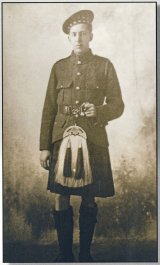
And how likely to end up as an inscription reading, in Rudyard Kipling's words: 'A soldier of the Great War, known unto God'. This studio photograph of a private soldier of the 4th SA Infantry was typical of the many taken for wives, girlfriends and parents, and which - apart from a trio of medals and a commemorative plaque - were often all that remained of a young life lost.
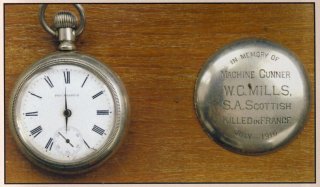
This fob watch, memorialising Private Walter Charles Mills of the 4th SA Infantry, was presented to the Transvaal Scottish Museum with the hope that more might be found about the reasons the watch was so engraved. But all we know is what the records tell us: that Walter Mills was born in Portsmouth, England, in 1880. A fitter by trade, he served for three years in the Second Anglo-Boer War and later in the Northern Rifles. Mills had been resident in Benoni when he headed off to Potchefstroom to attest in the 1st SA Infantry Brigade. He fought in the North Africa campaign before sailing for France to serve in 'B' Company of 4th SAI. As the inscription states, Mills was a machine gunner. He was killed on 15 July 1915 at Delville Wood and buried in the Quarry Cemetery at Montauban, west of Combles. After the war, when the then Imperial War Graves Commission began establishing the cemeteries as we know them today, the Quarry site was opened for the purpose of concentration elsewhere. This time, however, no trace of Mills' body could be identified, so with no known grave he is recorded on the great Thiepval Memorial among the more than 73 000 British and Commonwealth servicemen who fell without trace on the Somme between July 1916 and 20 March 1918. Did his wife Elizabeth commission this engraving, or one of his three children? The mystery endures.
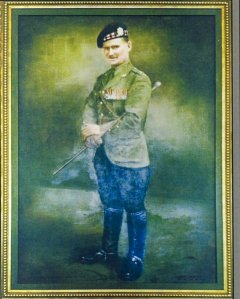
This portrait of Lieutenant Colonel Donald Macleay Macleod, DSO, MC, DCM, now hangs in the Officers' Mess of the Transvaal Scottish at 'The View'. An Inverness man, he was said to have been the youngest sergeant major in the British Regular Army during Kitchener's Sudan Campaign of 1895, when he fought with the Queen's Own Cameron Highlanders. He took part in the Second Anglo-Boer War and transferred to the regular staff of the Transvaal Scottish Volunteers (as the regiment was known at its formation in 1902). He was Regimental Sergeant Major until 1905, and then again from 1908 to 1912, by which time the name had changed to the Transvaal Scottish Regiment. He was soon commissioned, and as a captain was adjutant of 1st Bn Transvaal Scottish, before being appointed second-in-command of the 4th SA Infantry at its formation in 1915. He fought through Delville Wood, taking command of the SA Scottish following the death in Bernafay Wood of Lieutenant Colonel F A Jones, DSO. At the end of the First World War, McLeod fought in North Russia against the Bolsheviks (for which he received the Order of St Anne), following which he commanded the Transvaal Scottish Regiment from 1920 to 1923. He died in 1942 in Kenya while serving yet again, this time as a welfare officer for South African forces. His medals, presented by his daughter, are displayed in the Transvaal Scottish Museum.
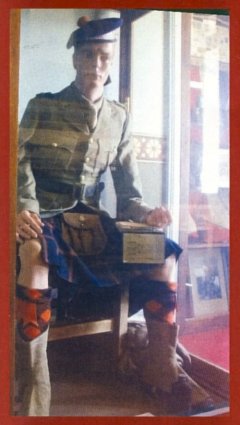
Cyril Choat wore this uniform while on an officers' training course at Oxford University in early 1918, having been selected from the ranks of the 4th SAI. Shortly after returning to his unit, Second Lieutenant Choat was mortally wounded in his first battle as a commissioned officer, on 11 April 1918 at Messines Ridge. He died thirteen days later.
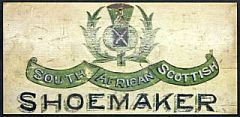
So goes the old army saying. This was one of a number of signs painted during the two months' training period at Bordon Camp, in Hampshire, before the 4th SA Infantry headed across the Channel to France. With suitable modifications, this and another such sign were later used by the Transvaal Scottish when in camp.
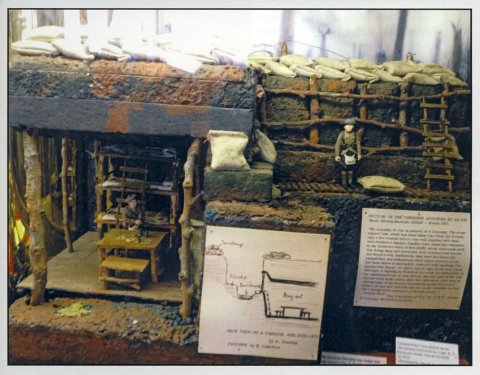
Lightfoot, K, and Duminy, A, are credited with constructing this detailed model illustrating the 'better' side of life in the Somme trenches, if there could be such a thing. According to J E P Levyns, of 4th SA Infantry - author of The Disciplines of War - 'My company, B, was in support of A Company. The close support line, which had been taken over from the French only a few months before, was well supplied with deep, well-timbered dugouts. Candles were stuck into recesses in the timbered walls of this stuffy, warm man-made cave. The firing bays and traverses were rivetted [sic] with timber and floored with duckboards. Only here and there did inequalities and indentations show where several yards had been blown in and hastily repaired with sandbags. The ground was frozen, so there was no sign of the mud, which accounts of the fighting in Flanders had made me dread. Even to my unpractised eye, it was obvious that this part of the line had not been under heavy shell fire like those I had seen in photographs of the Somme battlefields in the illustrated papers. It was neat and tidy like the model trenches we had used during battle practices at Bordon Camp.'
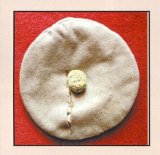
Sergeant E A Symons wore this khaki tam o'shanter on 7 October 1918 during an attack - in the face of heavy machine gun fire - on Beaurevoir (about 30km due east of Delville Wood). A bullet sliced through the crown of his tam and almost creased his scalp, bringing him literally within a hair of death. Four officers and 45 men were killed and a further 914 wounded. Had Sergeant Symons been a touch taller he could never have survived to present this to the Transvaal Scottish Museum in 1974.
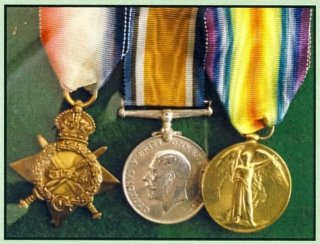

These medals were earned by Private Robert McDonald of the 4th SA Infantry. He was killed on 15 July 1915 at Delville Wood, and the medals, together with the commemorative death plaques ometimes ghoulishly nicknamed the 'Dead Man's Penny' - were forwarded to his parents.
Booted and spurred ... An officer and a private soldier of the SA Scottish, with the field-rank officer - theoretically entitled to be mounted wearing Murray of Atholl riding breeches. The soldier beside him carries an SMLE rifle, with its long sword bayonet easily accessible on his left side.
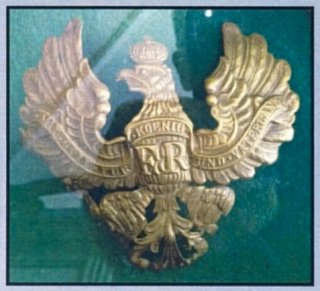
How closely the motto on this German helmet badge, picked up from the battlefield, echoes the sentiments that were common on the British and Commonwealth side.
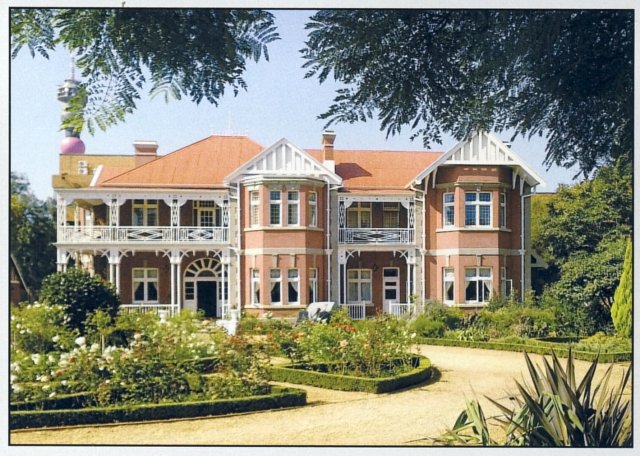
'The View', on Johannesburg's Parktown ridge, was built for Sir Thomas Cullinan in 1897. The name comes from the once-amazing vista all the way to the Magaliesberg on a clear day ... now sadly lost because of public works in the 1950s and 1970s. The house was built regardless of expense in an era when the mining magnates of the Witwatersrand vied with each other in their building endeavours. Sir Thomas's new home featured parquet flooring imported from Sweden, and plastered ceilings adorned with cherub and flower designs by a German artist. The hand-painted detailing along the walls in the entrance hall - all lovingly restored in recent years - speaks of a bygone age when craftsmen and artists catered to every whim of the newly rich Randlords.
'The View' houses the Transvaal Scottish Regimental Association and the Regimental Council of the Transvaal Scottish, as well as the Regimental Museum.
For family, friends, or business, 'The View' presents a unique venue. Johannesburg's oldest remaining residence can host from seven to seventy participants, with optional outside marquee space. From completely casual to fully formal, from braai to four-course fully catered dining, 'The View' suits both family and business entertaining.
'The View', 18 Ridge Road, Parktown, Johannesburg.
GPS: 26' 10' 51" S, 28' 2' 42" E
Information, bookings: Ian Hooper (072)321 4860/ (011 )6432961
email: tvlscottish@telkomsa.net
Return to Journal Index OR Society's Home page
South African Military History Society / scribe@samilitaryhistory.org